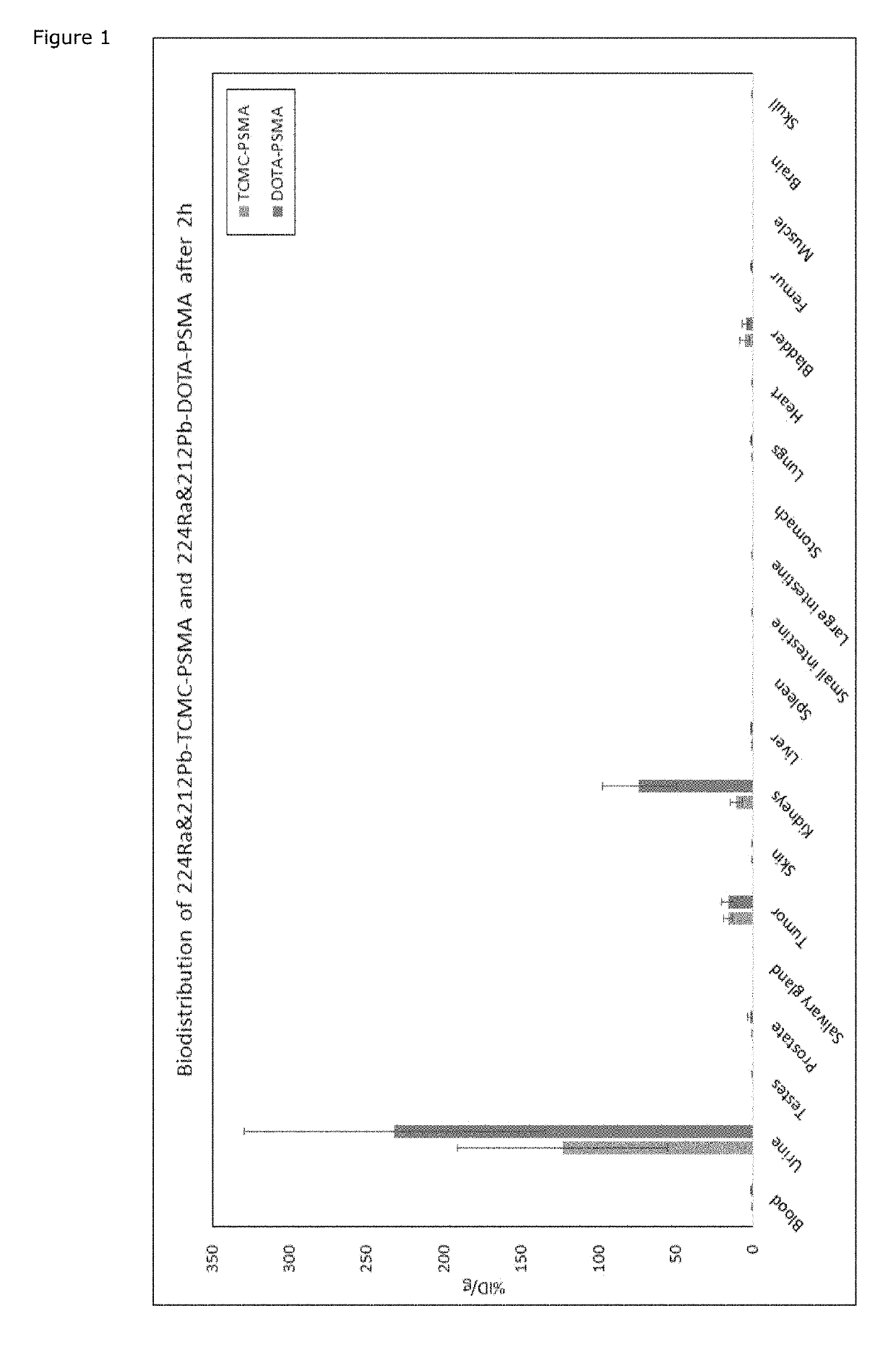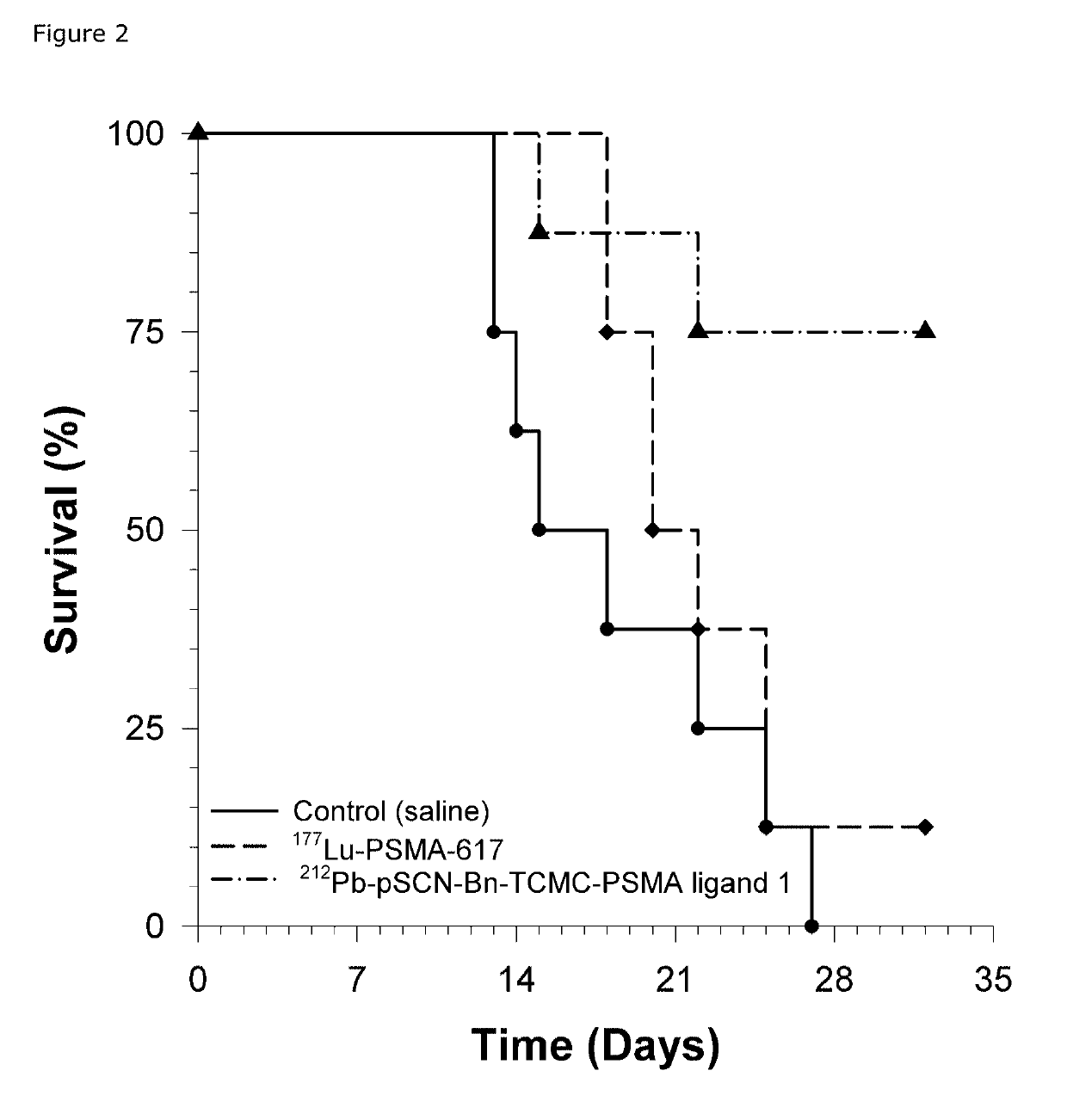Novel lead and thorium compounds
a technology of lead and thorium, applied in the field of new lead and thorium compounds, can solve the problems of low radiobiological efficacy, potential toxicity of initial kidney uptake, and suboptimal biodistribution
- Summary
- Abstract
- Description
- Claims
- Application Information
AI Technical Summary
Benefits of technology
Problems solved by technology
Method used
Image
Examples
example 1
A-Binding Chelator Ligands Compared with PSMA-617
[0213]Background: Several carrier molecules for radioligand targeting of prostate specific membrane antigen (PSMA) exists. Lutetium-177 labeled PSMA-617 (177Lu-PSMA-617) is the compound in most advanced clinical development stage for use in radionuclide therapy. This molecule works well and give relevant tumor to normal tissue ratios for longer lived (i.e., a half-life of a few days) radionuclides, including 177Lu and 225Ac, but at early times points (typically a few hours after injection) shows high uptake in kidneys. With shorter lived radionuclides like 212Pb (half-life of 10.6 hours), the initial kidney uptake represents a potential toxicity problem. It is therefore advantageous to use a PSMA-ligand with less kidney uptake, but this should not compromise the tumor uptake. The PSMA ligand molecules are made up of (1) a PSMA-binding region, (2) a linker region and (3) a chelator, whereby the linker region connects the (1) and (3). T...
example 2
[0222]A carbon substituted p-SCN-Bn-DOTA-PSMA ligand 2 for radiolabeling with 212Pb, 212Bi, 213Bi, 225Ac, 227Th, 177Lu, etc.
[0223]Compared to PSMA-617 the ligand has larger size and a p-SCN-Bn-DOTA group, i.e., both a different linker region and a different DOTA-chelator version where all four chelator arms are free to cause chelation of radionuclides as compared to PSMA-617.
[0224]The p-SCN-Bn-DOTA-PSMA ligand 2 is the DOTA analogue of p-SCN-Bn-TCMC-PSMA ligand 1 described in example 1 and has carbon linker to the chelator backbone leaving the chelator groups free to interact with the radiolabel and is therefore expected to improve chelate stability after radionuclide labelling compared with radiolabelled PSMA-617. Due to the additional lipophilic benzyl unit in the linker region and larger size of molecule, less kidney uptake is expected compared with PSMA-617. This molecule can be synthesized in the same fashion as p-SCN-Bn-TCMC-PSMA ligand 1 by using a DOTA based precursor instea...
example 3
ides Tested
[0229]Lutetium-177 was purchased as ready to use 177LuCl3 dissolved in diluted HCl. Lead-212 was obtained from 224Ra based solutions. Radium-224 was made from 228Th bound to Actinide resin (Eichrom Technologies, LLC) by eluting a column containing actinide resin with immobilized 22Th with 1 M HCl. The eluate was purified on a second Ac-resin column and the eluate evaporated to dryness using an evaporation vial with a cap with gas inlet and outlet placed in a heater block at approximately 110° C. and a gentle stream of nitrogen gas to evaporate of the solvent. When the evaporation vial was empty from solvent it was added 0.1 M HCl to dissolve the residue, typically 200-400 μl.
PUM
| Property | Measurement | Unit |
|---|---|---|
| pharmaceutical composition | aaaaa | aaaaa |
| radioactive | aaaaa | aaaaa |
| radioactivity | aaaaa | aaaaa |
Abstract
Description
Claims
Application Information
 Login to View More
Login to View More - R&D
- Intellectual Property
- Life Sciences
- Materials
- Tech Scout
- Unparalleled Data Quality
- Higher Quality Content
- 60% Fewer Hallucinations
Browse by: Latest US Patents, China's latest patents, Technical Efficacy Thesaurus, Application Domain, Technology Topic, Popular Technical Reports.
© 2025 PatSnap. All rights reserved.Legal|Privacy policy|Modern Slavery Act Transparency Statement|Sitemap|About US| Contact US: help@patsnap.com



